60 minutes in an hour.
24 hours in a day.
7 days in a week.
52 weeks in a year.
All of the above are facts about time.
Another fact: We all have the same amount of time, regardless of what industry you work in, what job you have, how much money you make, and so on.
Time is finite.
And yet some of us get more (stuff) done, while others seem always to have overflowing plates.
Sure, you may be taking on too much work, but more than likely, you don’t get as much work completed because you struggle with managing the time in your day.
Get this: According to this UK study, the average office worker is productive for less than 3 hours per day.
Yikes.
Checking social media, reading news websites, discussing out-of-work activities with colleagues, making hot drinks … and even searching for new jobs make up the other 5+ hours of the average workday.
It’s time to refocus and learn how to manage our days better.
The best way to accomplish this? Time management systems.
Time management systems help individuals prioritize tasks and reclaim some of those working hours.
In this article, we’ll review some of the most popular time management systems, including the Eisenhower Framework, GTD, Time Tracking, Time Blocking, and the Pomodoro Technique … and share how monday.com can help keep track of it all!
Time Management System #1: The Eisenhower Framework
President Dwight D. Eisenhower is quoted as saying, “I have two kinds of problems, the urgent and the important. The urgent are not important, and the important are never urgent.”
Years later, author Stephen Covey helped popularize the quote into a time management framework in his book The 7 Habits of Highly Effective People: Powerful Lessons in Personal Change.
The Eisenhower Framework — sometimes called the Eisenhower Decision Principle or The Eisenhower Method — is a model that helps prioritize tasks by filtering out what’s urgent and essential from those that are, well … not.
The framework divides tasks into 4 quadrants, each with a different work strategy:
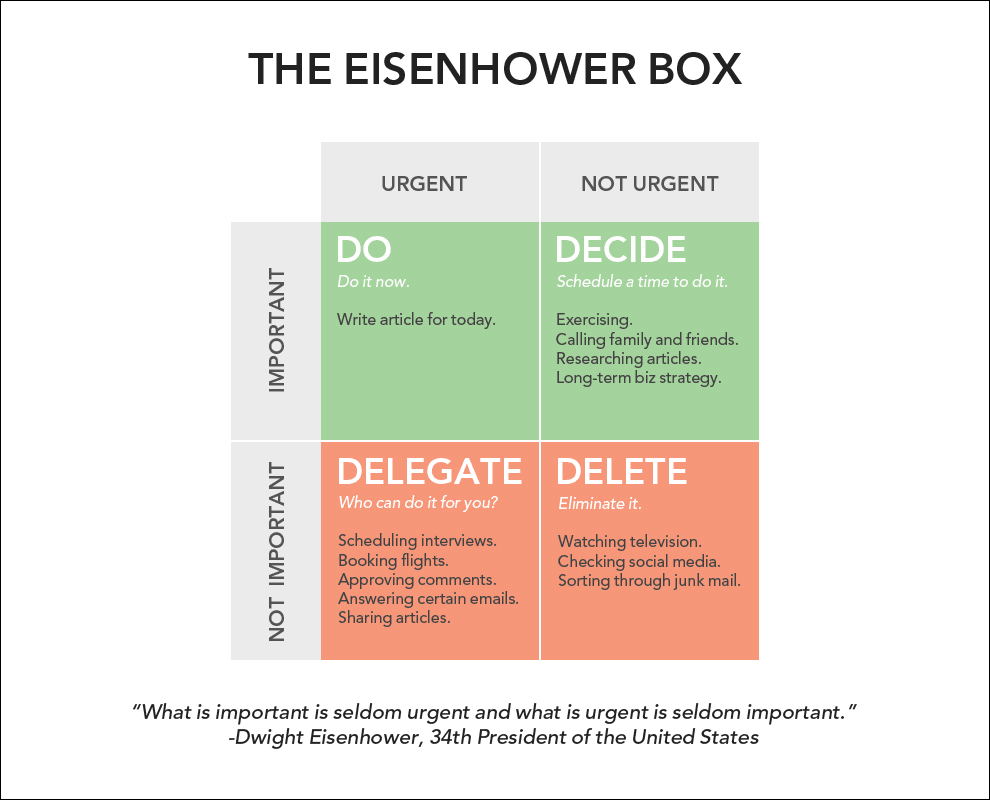
Quadrant 1 (“DO”): Urgent, important: These are tasks that must get done … or else. They are typically done immediately and personally (as in, NOT delegated to another team member). Tasks in this quadrant are often called “fire fighting” jobs or “drop everything you’re doing” urgent and important moments.
Q1 is sometimes called the Quadrant of Necessity.
Quadrant 2 (“DECIDE”): Important, not urgent: This quadrant is where you should spend the majority of your time … but most people do not!
Items in this quadrant generally require large blocks of uninterrupted time to get into a flow state and truly focus. If possible, put these tasks on a calendar and schedule them for future dates/times.
Q2 is sometimes called the Quadrant of Quality.
Quadrant 3 (“DELEGATE”): Urgent, not important: Tasks in this quadrant are often distractions. They should be (a) delegated or (b) automated or (c) both. We often spend time in this quadrant helping others meet their goals.
If possible, try to spend as little time as possible here. Most tasks that live in this quadrant are counterproductive … not contributing to the larger goal.
Q3 is sometimes called the Quadrant of Deception.
Quadrant 4 (“DELETE”): Not urgent, not important: In an ideal world, you would spend zero of your time here. Not urgent. Not important. Don’t do!
That being said, we are all human. Trivial, “busy work” falls into this category, as does checking social media (for non-work-related reasons) and other unimportant items.
Q4 is sometimes called the Quadrant of Waste.
Not surprisingly, monday.com has an Eisenhower Matrix template to get you started!
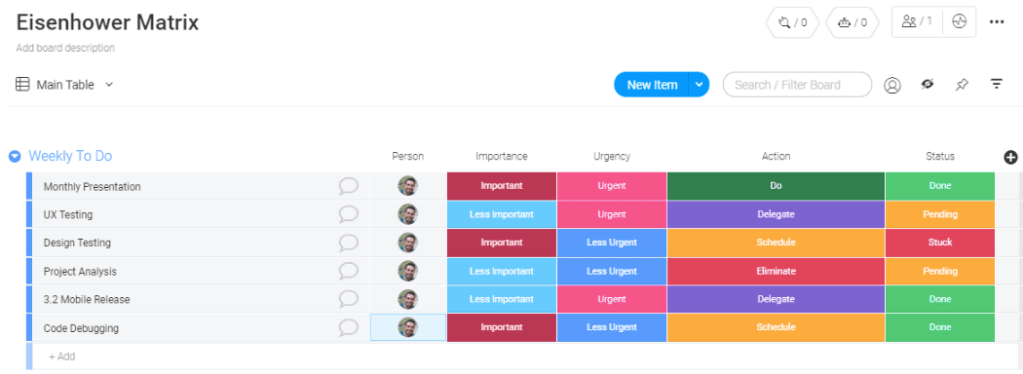
The Eisenhower matrix template provides a way to record your tasks and prioritize them based on their urgency and importance. Then, you can decide whether or not to do the job yourself and to do it immediately, delegate the task to someone else, schedule the item for a specific time in the future or eliminate the task.
Read more about the Eisenhower Matrix.
Time Management System #2: GTD
GTD (or “Get Things Done”) is a time management method that helps focus attention on taking action rather than recalling tasks.
In 2001, author David Allen published a book titled, Getting Things Done: The Art of Stress-free Productivity. His accompanying website outlines the 5 steps of GTD:
Step #1: Capture: Collect what has your attention
Step #2: Clarify: Process what it means
Step #3: Organize: Put it where it belongs
Step #4: Reflect: Review frequently
Step #5: Engage: Simply do
We go into a lot more detail in “How to GTD with monday.com,” but to get started, we recommend creating a “Bucket List” board, like the one here:
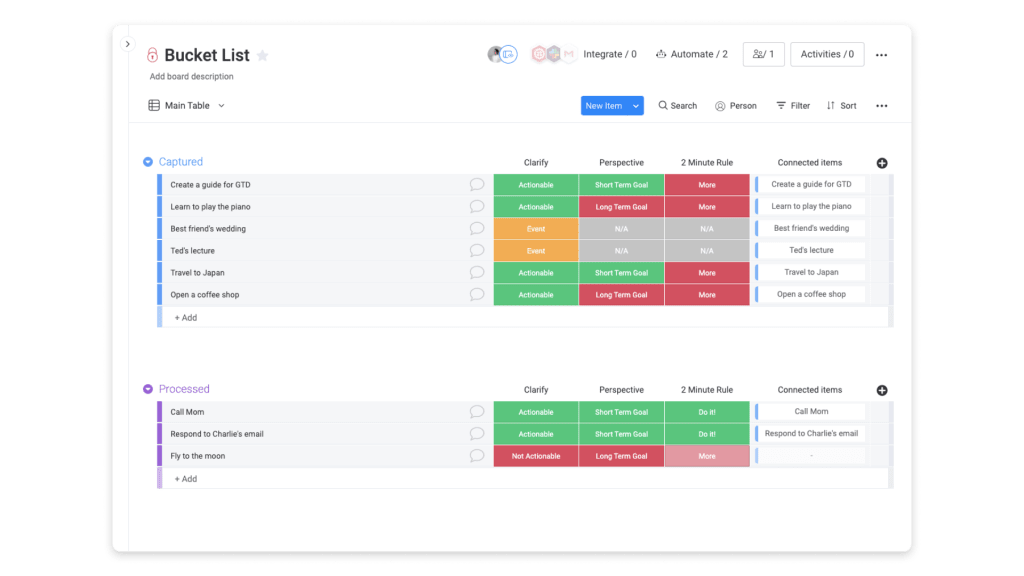
Remember: Step #1 is “capture” — the time to collect what has your attention. On this board, drop in all of your ideas and thoughts as items. We recommend creating 3 status columns.
- Clarify: Is this task actionable or not?
- Perspective: Is the goal short or long-term?
- 2-minute rule: Will the task take 2 minutes or less to complete? If the answer is yes, then do it!
And then you are off!
Time Management System #3: Time Tracking
Time tracking quantifies the value of the amount of work that went into a task. Therefore, tracking time can be valuable when forecasting how much time should be allocated for a project.
Time tracking software (like monday.com) can help track and visualize how much time is spent on each task.
There are 3 main categories of time tracking software:
- Individual task tracking: A simple method with manually defined start and endpoints for tasks. This time is then stored in the tracking program for monitoring and reporting.
- Team tracking: A sum of time it takes for a team to complete all tasks within a project
- Whole-project tracking: The total time it takes to complete an entire project. The time starts when the project kicks off and ends when all individual project tasks and sub-tasks are completed.
Here is an example of what time tracking could look like on a monday.com board:
And here is a short video showcasing time how time tracking works on monday.com:
For a more detailed review of time tracking (software), read this.
Time Management System #4: Time Blocking
Focused work during specific blocks of time.
Simply put, that’s the definition of time blocking.
Tasks are outlined and scheduled for different dates and times. Then, you work on that task — and only that task — during the time block.
Time blocking forces focus, adds clarity and intention, and sets workday boundaries.
The five main steps to follow when installing a time blocking time management system are:
Step 1: Identify the tasks that need to be accomplished — make a list of the repetitive tasks you perform each week. You may want to automate some of these.
Step 2: Estimate how many hours each task should take — compile an estimate of how long it takes to complete each task. A rough estimate is fine.
Step 3: Decide how much flexible time you allot in your schedule — be sure to leave time for “unplanned emergencies” that will inevitably arise.
Step 4: Review your plan — add up your hours! Have extra time or more hours than your work day? Adjust accordingly. Remember: This may be an ongoing review/tweak process.
Step 5: Implement time blocking using your favorite calendar app — ready, set, go!
We recommend testing out the monday.com calendar widget/app:
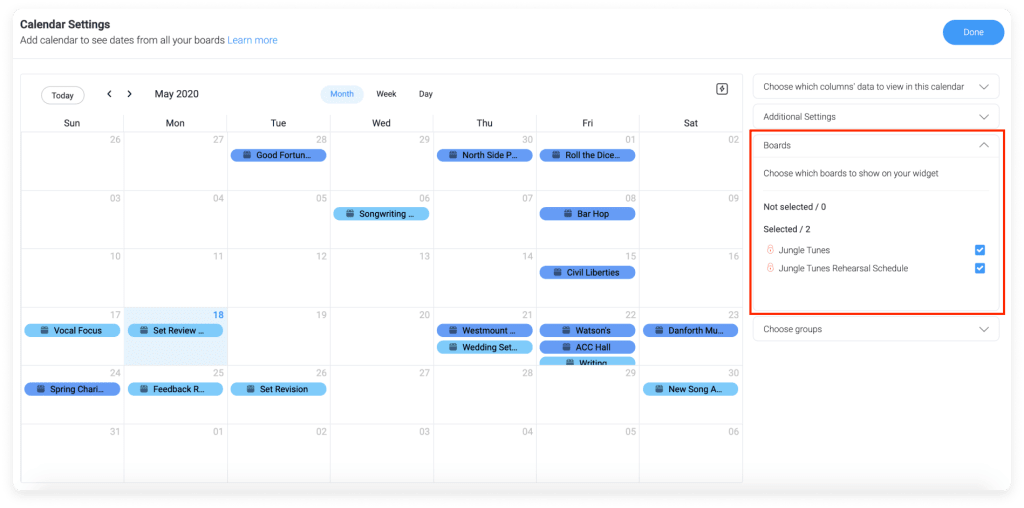
You can even start with a calendar template — like this one — and customize it to your liking.
Here is a step-by-step guide to using time blocking.
Time Management System #5: The Pomodoro Technique
The Pomodoro Technique, named after the pomodoro (tomato) kitchen timer, is a time management practice defined by 25 minutes of super-focused work followed by a 5-minute break.
It’s often recommended to knock out a “few pomodoros” (4-5) before taking a more extended break of 15-30 minutes.
This graphic sums it all up nicely:
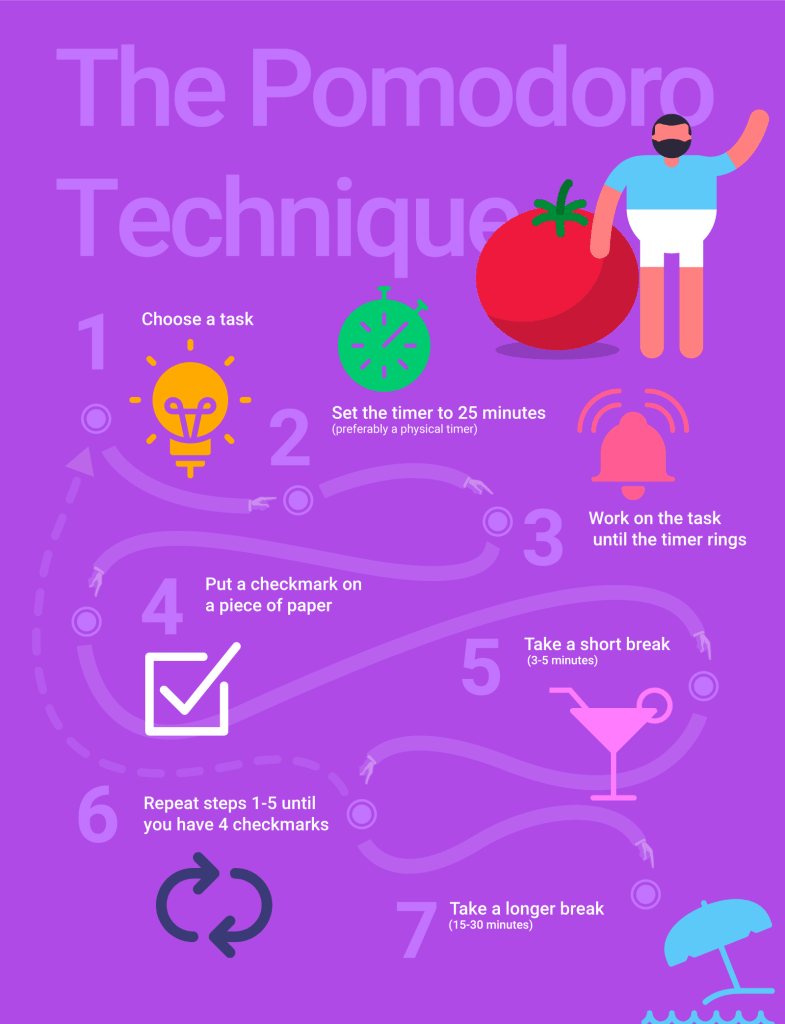
This time management system works best for procrastinators as it forces you to concentrate on a specific task … for 25 minutes.
We attempted the Pomodoro Technique a few years ago with mixed results.
What other time management techniques are there?
We’ve detailed a few of the more popular time management techniques above.
There are many (many) more to choose from.
Eat That Frog: Identify one crucial task for the day and do it first. We also tried this one a few years back. Spoiler alert: It didn’t work (for us).
The Kanban Board: Kanban is a visual strategy that leverages a board — consisting of columns and cards — to break down a project into actionable pieces. A basic Kanban board includes three columns for “Working on it,” “Done,” and “Stuck.”
There is also the 4-hour work week, the Now Habit, and so on.
No matter which time management system you implement, you can leverage a monday.com template to get you started. Choose from over 200 templates and get started today.
